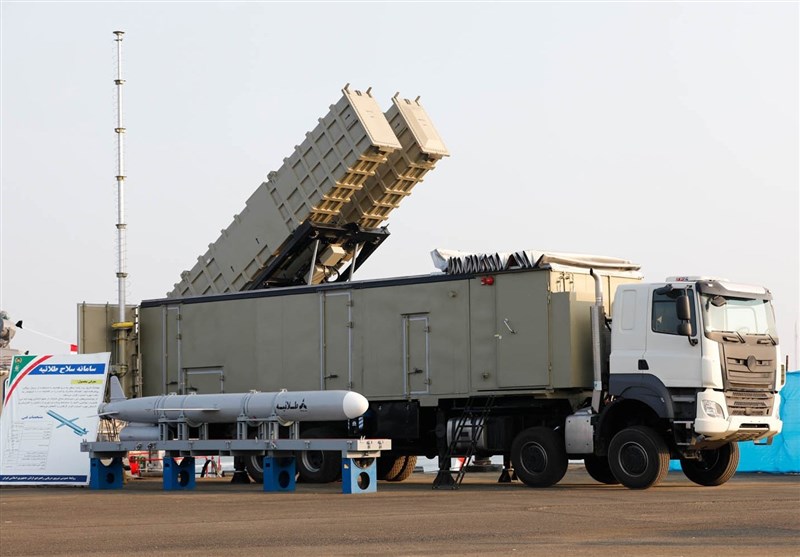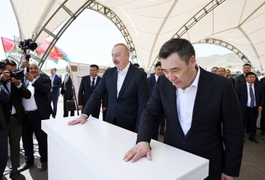Iran's Naval Forces unveiled new cruise missiles and electronic warfare-capable intelligence helicopters in a ceremony held in the south-eastern province on December 24.
The new equipment includes the Talaiyeh strategic cruise missile system, the Nasir cruise missile system, the Navy’s first electronic warfare helicopter and the first intelligence gathering helicopter, surface-to-surface missile systems, the Sanjar smart loitering and suicide drone carried by the Jamaran destroyer, a diver detection system, and the Sinvar tugboat for ports and anchorages, Iran’s Tasnim News Agency reported.
The unveiling ceremony was held in the third naval region Nabovvat, in the port city of Konarak in Sistan-Baluchestan Province.
According to Commander of Iran's Navy Rear Admiral Shahram Irani, Talaiyeh is a smart missile with a range of over 1,000 km, and it can change its course and select targets.
He said that the range of the Nasir missile is more than 100 km, and added that the Navy is equipping its vessels with this missile system, one of which has already joined the third naval region fleet.
Referring to the new helicopters, Irani said that the new electronic warfare helicopter had software defence and was equipped with a missile deception system.
The commander added that the new intelligence helicopters are equipped with advanced cameras and identification friend or foe (IFF) systems.
The unveiling ceremony was held shortly after the US military blamed Iran for a drone attack on a vessel in the Indian Ocean. US CENTCOM announced on December 23 that a drone launched from Iran targeted and hit a chemical tanker in the Indian Ocean, known as the Chem Pluto.
It is the first time that the US has directly blamed Iran for an attack as maritime routes have become a key strategy for Iran's proxies amidst the war in Gaza.
A fire on the vessel was successfully extinguished, and there were no casualties. Iran has not commented. This came while Iran’s Yemeni proxy, the Houthis, announced a blockade of the Red Sea in allegiance to Iran-backed Hamas in its war against Israel.
On November 27, the US military said the carrier group had been deployed "in support of naval operations to ensure maritime stability and security in the Middle East region".
The deployment of the carrier group came as part of a broader US effort to boost its naval presence in the region following the outbreak of the Israel-Gaza War on October 7. The Iranian navy carried out an interception of the USS Dwight D. Eisenhower carrier group using drones on November 26. On December 15, IRGC Navy Commander Alireza Tangsiri announced the departure of the USS Eisenhower carrier group from the Gulf.
On December 19, Commander Rear Admiral Tangsiri said that the force has organised a voluntary Basij maritime unit, which is the paramilitary arm of the IRGC.
He said that the maritime Basij in the Gulf included 55,000 forces and 33,000 vessels, and noted that the second phase of the force would be in the Caspian Sea.
The commander noted that the next step was the creation of a "shadow navy", and that the IRGC had already stationed basic vessels with mounted 107mm rocket launchers in coastal villages for Basij use when necessary.
Tangsiri said that the IRGC had formed the "naval Basij for ocean missions" in recent years and that the force had access to "large vessels and barges that can sail to Tanzania".
Iran possesses one of the largest missile programs in the Middle East, and asserts that its missiles can reach Israel and US bases in the region. Despite opposition from the US and European countries, Iran maintains that its ballistic missiles serve as a deterrent and retaliatory force against the US, Israel, and other potential regional adversaries.







 Kyrgyzstan has joined the extensive reconstruction efforts in the Karabakh region of Azerbaijan, after a series of mega initiatives were launched b...
Kyrgyzstan has joined the extensive reconstruction efforts in the Karabakh region of Azerbaijan, after a series of mega initiatives were launched b...
 President Ilham Aliyev shed light on the evolving contours of the peace process with Armenia during an international conference in Baku this week. ...
President Ilham Aliyev shed light on the evolving contours of the peace process with Armenia during an international conference in Baku this week. ...
 Azerbaijan and Armenia started the process of demarcation of their border on Tuesday, with the installation of the first border markers based on ge...
Azerbaijan and Armenia started the process of demarcation of their border on Tuesday, with the installation of the first border markers based on ge...
 Iran and Pakistan have signed eight cooperation documents in various fields, and agreed to strengthen ties to fight terrorism in the region.
Iran and Pakistan have signed eight cooperation documents in various fields, and agreed to strengthen ties to fight terrorism in the region.
 As the conflict between Ukraine and Russia escalates, the strategic importance of Kharkiv, Ukraine's second-largest city, has come sharply into focus.
As the conflict between Ukraine and Russia escalates, the strategic importance of Kharkiv, Ukraine's second-largest city, has come sharply into focus.



